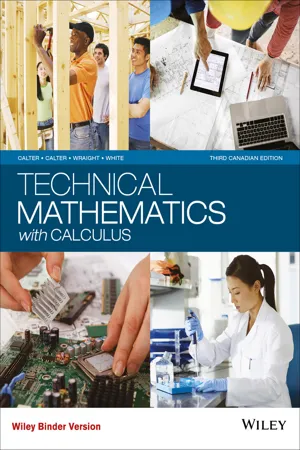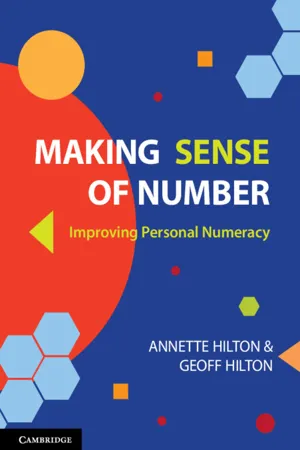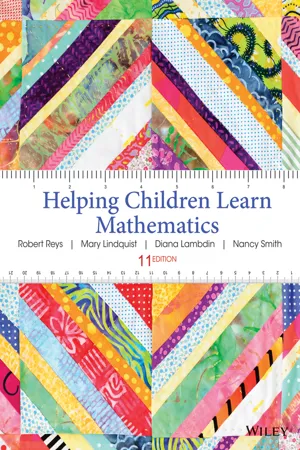Mathematics
Fractional Ratio
A fractional ratio is a comparison of two quantities expressed as a fraction. It represents the relationship between a part and the whole, where the numerator represents the part and the denominator represents the whole. Fractional ratios are commonly used in mathematics and are essential for understanding proportions and solving problems involving relative quantities.
Written by Perlego with AI-assistance
Related key terms
1 of 5
9 Key excerpts on "Fractional Ratio"
- eBook - ePub
Teaching Mathematics in Primary Schools
Principles for effective practice
- Robyn Jorgensen, Shelley Dole, Kevin Larkin(Authors)
- 2020(Publication Date)
- Routledge(Publisher)
Ratio and proportion are two concepts that present a challenge to both teachers and students. Proportional reasoning is fundamental to understanding many topics in the middle-school curriculum, such as the geometry of plane shapes, trigonometry and, particularly, percentages, as well as rate, ratio and proportion applications. As Lesh and colleagues (1988) state, 'Proportional reasoning is the capstone of children's elementary school arithmetic and the cornerstone of all that is to follow' (pp. 93-4). Traditionally, ratio and proportion were considered topics for upper-primary and secondary grades. However, teachers at all year levels need to provide students with rich experiences and appropriate activities in order for them to develop understanding of these topics, so that students will later be able to apply this knowledge in a meaningful way. Teachers of early primary classes must ensure that the seeds of the concepts are sown in their students' minds in the early years, and as students move through the grades, all teachers must build on and extend this knowledge. Ratio and fractions Ratios are commonly described as fractions. In the true mathematical sense, fractions are ratios in that they are rational numbers that can be expressed in the form a/b (provided that b does not equal zero). However, the general meaning of fraction, of being part of a whole (as described in the previous section), interferes with the conceptual meaning of ratio. Continuing with the previous example, it was stated that the ratio of boys to girls in the class is two to three—that is, for every two boys there are three girls. When this is considered in the context of the Teaching Idea Ratio language through pattern For every 2 black there is 1 yellow For every 3 circles there is 1 square whole class, there is a base unit of five children, of whom two are boys and three are girls. The boys and girls situation describes the two parts of the whole unit of children - Frank K. Lester(Author)
- 2005(Publication Date)
- Information Age Publishing(Publisher)
Abstraction entails imposing a rela-tional structure, a classification scheme apart from the object, event, or image in which it is exemplified. It is not a per ception as much as it is a con ception. The con-struction and use of ratios as measures is one example. In the previous example, the quantities 8 people and 2 pounds of nuts relied on counting and weighing, two activities with which most people are comfortable. How-ever, the quantity pounds per person is both a relationship between the other two quantities, people and pounds, and a new measure derived from the other two measures by considering their ratio. The underlying concept of ra-tio (a relationship between a pair of quantities) is funda-mental to fractions (in arithmetic), to rates (in physics), to similarity transformations (in geometry), and to probabili-ties (in statistics), just to name a few mathematical applica-tions. Density, slope, and speed, for example, are all called intensive quantities and they differ from extensive quanti-ties (those that tell numerosity, length, height, time, etc.). They are, in fact, not directly observable and not directly measurable. Intensive quantities are relationships (com-parisons or ratios) between two other quantities. In short, relative or comparative thinking, as opposed to absolute thinking, is needed to move beyond the sense data. Relative thinking activities provide the opportunity for students to further expand the range of applicabil-ity of certain words that were formerly only associated with additive concepts (Pimm, 1987). For example, the word more . Although most children will be familiar with the word as a signal word for addition/subtraction, the word can have a proportional or relational meaning: RATIONAL NUMBERS AND PROPORTIONAL REASONING ■ 651 Being able to see that 2 girls comprise a larger proportion of the King family ( 1 2 or 50%) than they do of the Jones family ( 2 5 or 40%) is related to under-standing percent increase/decrease problems.- eBook - PDF
- Alan Tussy, Diane Koenig(Authors)
- 2018(Publication Date)
- Cengage Learning EMEA(Publisher)
Cengage Learning reserves the right to remove additional content at any time if subsequent rights restrictions require it. CHAPTER 6 • Ratio, Proportion, and Measurement 542 OBJECTIVE 1 Write ratios as fractions. Ratios give us a way to compare two numbers or two quantities measured in the same units. OBJECTIVES 1 Write ratios as fractions. 2 Simplify ratios involving decimals and mixed numbers. 3 Convert units to write ratios. 4 Write rates as fractions. 5 Find unit rates. 6 Find the best buy based on unit price. SECTION 6.1 Ratios and Rates Ratios are often used to describe important relationships between two quantities. Here are three examples: To prepare fuel for an outboard marine engine, gasoline must be mixed with oil in the ratio of 50 to 1. To make 14-karat jewelry, gold is combined with other metals in the ratio of 14 to 10. In this drawing, the eyes-to-nose distance and the nose-to-chin distance are drawn using a ratio of 2 to 3. 2 3 Ratios A ratio is the quotient of two numbers or the quotient of two quantities that have the same units. There are three ways to write a ratio. The most common way is as a fraction. Ratios can also be written as two numbers separated by the word to, or as two numbers separated by a colon. For example, the ratios described in the illustrations above can be expressed as: 50 1 , 14 to 10, and 2 : 3 n The fraction 50 1 is read as “the ratio of 50 to 1.” A fraction bar separates the numbers being compared. n 14 to 10 is read as “the ratio of 14 to 10.” The word “to” separates the numbers being compared. n 2 : 3 is read as “the ratio of 2 to 3.” A colon separates the numbers being compared. Writing a Ratio as a Fraction To write a ratio as a fraction, write the first number (or quantity) mentioned as the numerator and the second number (or quantity) mentioned as the denominator. Then simplify the fraction, if possible. Copyright 2019 Cengage Learning. - Alan Tussy, Diane Koenig(Authors)
- 2018(Publication Date)
- Cengage Learning EMEA(Publisher)
Cengage Learning reserves the right to remove additional content at any time if subsequent rights restrictions require it. CHAPTER 5 • Ratio, Proportion, and Measurement 410 OBJECTIVE 1 Write ratios as fractions. Ratios give us a way to compare two numbers or two quantities measured in the same units. OBJECTIVES 1 Write ratios as fractions. 2 Simplify ratios involving decimals and mixed numbers. 3 Convert units to write ratios. 4 Write rates as fractions. 5 Find unit rates. 6 Find the best buy based on unit price. SECTION 5.1 Ratios and Rates Ratios are often used to describe important relationships between two quantities. Here are three examples: To prepare fuel for an outboard marine engine, gasoline must be mixed with oil in the ratio of 50 to 1. To make 14-karat jewelry, gold is combined with other metals in the ratio of 14 to 10. In this drawing, the eyes-to-nose distance and the nose-to-chin distance are drawn using a ratio of 2 to 3. 2 3 Ratios A ratio is the quotient of two numbers or the quotient of two quantities that have the same units. There are three ways to write a ratio. The most common way is as a fraction. Ratios can also be written as two numbers separated by the word to, or as two numbers separated by a colon. For example, the ratios described in the illustrations above can be expressed as: 50 1 , 14 to 10, and 2 : 3 n The fraction 50 1 is read as “the ratio of 50 to 1.” A fraction bar separates the numbers being compared. n 14 to 10 is read as “the ratio of 14 to 10.” The word “to” separates the numbers being compared. n 2 : 3 is read as “the ratio of 2 to 3.” A colon separates the numbers being compared. Writing a Ratio as a Fraction To write a ratio as a fraction, write the first number (or quantity) mentioned as the numerator and the second number (or quantity) mentioned as the denominator. Then simplify the fraction, if possible. Copyright 2019 Cengage Learning.- eBook - PDF
- Michael A. Calter, Paul A. Calter, Paul Wraight, Sarah White(Authors)
- 2016(Publication Date)
- Wiley(Publisher)
9–1 Simplification of Fractions Parts of a Fraction A fraction has a numerator, a denominator, and a fraction line. fraction line a b numerator denominator Quotient A fraction is a way of indicating a quotient of two quantities. The fraction a/b can be read “a divided by b.” The two ways of writing a fraction, a b and a/b, are equally valid. Ratio We also speak of the quotient of two numbers or quantities as the ratio of those quantities. Thus the ratio of x to y is x y . 9 ◆◆◆ OBJECTIVES ◆◆◆◆◆◆◆◆◆◆◆◆◆◆◆◆◆◆◆◆◆◆◆◆◆◆◆◆◆◆◆◆◆◆◆◆◆◆◆◆◆◆◆◆◆◆◆◆◆◆◆◆◆◆◆◆◆◆◆ When you have completed this chapter, you should be able to: • Simplify fractional expressions. • Multiply and divide fractional expressions. • Add and subtract fractional expressions. • Simplify complex fractional expressions. • Solve fractional equations. • Solve word problems using fractional equations. • Manipulate and work with literal equations and formulas. You already know about fractions with numbers. In algebra, however, the numbers are replaced with letters, coefficients, and even entire expressions. Many equations and formulas in science and technology are in the form of a fraction. Since the rules of working with the numerators and denominators of fractions must be applied to entire algebraic expressions, we’ll need to make much use of the factoring techniques of Chapter 8 in order to simplify them. As we work with formulas that include fractions, we must be careful: it’s very easy to make mistakes when we cross multiply. Remember that any- thing you do must be done to each term on both sides of the equation. Also, don’t be intimidated by complex fractions where a numerator or denominator might contain a fraction; use your skills and take it one step at a time. Not all of this material is new to us. Some was covered in Chapter 2, and we solved simple fractional equations in Chapter 3. Fractions and Fractional Equations - eBook - PDF
- Robert Reys, Mary Lindquist, Diana V. Lambdin, Nancy L. Smith, Anna Rogers, Audrey Cooke, Bronwyn Ewing, Kylie Robson(Authors)
- 2021(Publication Date)
- Wiley(Publisher)
Ratio tables provide an excellent model for exploring patterns involving ratios. A proportion provides a relationship between two or more ratios. Together with proportion, ratios provide an opportunity to practise many computational skills as well as strengthen problem-solving skills. Proportions provide a way to find answers to problems where the numbers are relational. These relationships may be considered additive (absolute) or multiplicative (relative). Children often apply additive procedures to proportions that require multiplicative thinking, particularly in dealing with like quantities. The ability of children to apply multiplicative thinking or proportional reasoning is an important instructional goal and is one of the reasons proportional reasoning has been called the capstone of primary school mathematics. The use of the double number line is a powerful model for helping children engage in proportional reasoning. Proportional reasoning is complex, both in terms of the mathematics and of the developmental experiences it requires. Yet it is an important skill for children to gain because it facilitates algebraic thinking. Ratios and proportions also provide a natural means of studying percentages, which has a comparison base of 100. Because few mathematical topics have a more practical usage than percentages, it is essential that meaningful and systematic development of percentages be provided. Instruction should use concrete models to support foundational percentage concepts. Key among those concepts are benchmarks of 100% and 50% as well as 90%, 10% and 1%. These benchmarks provide anchors for children to solve a wide range of problems involving percentages and to gauge the reasonableness of their answer. 464 Helping children learn mathematics THINGS TO DO: FROM WHAT YOU’VE READ 1 Given the importance of context, provide a real-life example of a ratio and a proportion. - Mary M. Hatfield, Nancy Tanner Edwards, Gary G. Bitter, Jean Morrow(Authors)
- 2012(Publication Date)
- Wiley(Publisher)
11 Percent, Ratio, Proportion, and Rate WHERE’S THEMATHEMATICS? THE MATHEMATICAL STRUCTUREOF PERCENT, RATIO, PROPORTION, ANDRATE The study of ratio, proportion, percent, and rate largely involves activities for grade 5 through grade 8. From decimals, students proceed to the study of ratio and percent, two other focal points in the study of rational numbers. Proportion is an exten- sion of the comparisons developed when studying ratio. Rate is another way of comparing relation- ships. All four concepts have many real-world applications and frequently become topics of word problems in elementary and middle school pro- blem solving. If you would like to review the defini- tions and some algebraic examples, go to ‘‘Check Your Knowledge’’ (Chapter 11, on the Web site). Figure 11.1 gives a partial listing of the NCTM standards related to percent, ratio, proportion, and rate. For a more complete listing, check the NCTM Web site at http://standards.nctm.org/ index.htm. You may be asking, ‘‘Why are these four math- ematical concepts placed together in a chapter?’’ It is of interest that they are related. Let’s look at the following word problem as an example. The pro blem: Mateo rewards himself with three bite-size candies every time he gets a hit in baseball. Figure 11.2 shows how rewording can change the problem from one concept to another. All these problems have a multiplicative rela- tionship and a constant. In this example, the con- stant is the 3. The number of candies is three times the hits or c ¼ 3h. We will see how that under- standing is developed in each of the four concepts. In a school setting, each concept, although related, is initially presented separately, so we present them separately in this chapter as well. Chapter 11 At the Start ~~~~ KnowWhat ChildrenWill Be Doing .- eBook - PDF
Making Sense of Number
Improving Personal Numeracy
- Annette Hilton, Geoff Hilton(Authors)
- 2021(Publication Date)
- Cambridge University Press(Publisher)
Thinking fractionally can be harder to visualise than whole-number thinking so it might be handy to grab some simple hands-on materials like buttons or counters to help work your way through certain scenarios or learning activities. Fractional thinking can involve common fractions, decimals or percentages. As mentioned already, many people report difficulties with fractional thinking, and some identify it as the core reason for their lack of mathematical confidence. In this chapter some of the commonly identified difficulties are discussed, which we hope will allow you to relate to your personal experiences. Fractional thinking can doubtless become complicated, but in our day-to-day lives most of the numeracy situations involving fractions can be met with an understanding of a few basic fraction concepts. In school we probably encountered rather complex fractional algorithms, which are important for deep understanding of fractions but not so necessary for personal functional competence. To ground the chapter in personal number sense, images and scenarios from everyday situations will provide opportunities to illustrate and apply the fractional concepts. This chapter is focused on three types of fractions. The three main ways to think fractionally is with common fractions (e.g. 3 4 ), decimal fractions (e.g. 0.75) and percentages (e.g. 75%). We will start with common fractions. COMMON FRACTIONS The definition of a fraction that most people are aware of is that it is a ‘part of a whole’. This is a reasonable working definition, so we will keep working with it. This section deals with common fractions (called ‘vulgar fractions’ Common fractions are numbers that are expressed using two whole numbers in the form a b , as shown in Figure 7.1. For example: 1 2 , 3 4 , 11 20 , 12 7 110 Making Sense of Number in the past). A fascinating experience we have with many students is that they are able to identify the parts of a common fraction, but don’t know what the words mean. - eBook - PDF
- Robert Reys, Mary Lindquist, Diana V. Lambdin, Nancy L. Smith(Authors)
- 2014(Publication Date)
- Wiley(Publisher)
By emphasizing multiplicative relationships, you will help your students take advantage of the many opportunities to use these relationships in real-world situations. The Common Core State Standards for Mathematics makes it clear that students in elementary school and mid- dle school must be able to express appropriate relation- ships using fractions, ratios, proportions, and percents. In Table 13-1, note that although the main focus on ratio, pro- portion, and percent takes place at grade 6, there is a de- velopmental progression from grade 3 to grade 6 of the necessary underlying concepts. Here is an example to get you started thinking about ratios, proportions, and percents. Consider the prices of three carpets: TABLE 13-1 • Ratio and Proportion Standards for Grade 6 from CCSSM. The full CCSSI document is available at www.corestandards.org Understand ratio concepts and use ratio reasoning to solve problems • CCSS.Math.Content.6.RP.A.1 Understand the concept of a ratio and use ratio language to describe a ratio relationship between two quantities. For example, “The ratio of wings to beaks in the bird house at the zoo was 2:1, because for every 2 wings there was 1 beak.” “For every vote candidate A received, candidate C received nearly three votes.” • CCSS.Math.Content.6.RP.A.2 Understand the concept of a unit rate a/b associated with a ratio a:b with b 0, and use rate language in the context of a ratio relationship. For example, “This recipe has a ratio of 3 cups of flour to 4 cups of sugar, so there is 3/4 cup of flour for each cup of sugar.” “We paid $75 for 15 hamburgers, which is a rate of $5 per hamburger.” • CCSS.Math.Content.6.RP.A.3 Use ratio and rate reasoning to solve real-world and mathematical problems, e.g., by reasoning about tables of equivalent ratios, tape diagrams, double number line diagrams, or equations.
Index pages curate the most relevant extracts from our library of academic textbooks. They’ve been created using an in-house natural language model (NLM), each adding context and meaning to key research topics.








